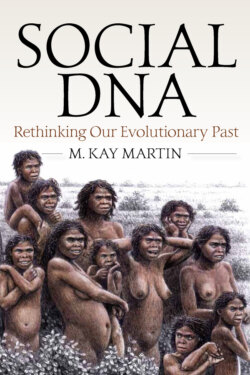Читать книгу Social DNA - M. Kay Martin - Страница 15
На сайте Литреса книга снята с продажи.
Science and Storytelling
ОглавлениеTheories on the nature of human nature and societal origins have always been an odd mix of empirical data and fanciful storytelling. I still have vivid memories of a lecture I attended in the 1960s in which my anthropology professor took a stumbling, bent-knee stroll across the stage to demonstrate the typical locomotion of ancient man. The fact that the speaker’s cranial morphology had strikingly Neandertaloid characteristics only served to add to the perceived drama and authenticity of the performance. Subsequent discoveries of additional, nonarthritic Neanderthal skeletons, of course, quickly put this misconception to bed. But not all notions on what life was like on the long road to humanity are so easily tested and modified. In fact, most theories are forced to address many open questions about the course of human evolution, the answers to which will probably remain unknowable.
Why is this? The tangible evidence we have in hand to trace our evolutionary pathway is fragmentary, and may remain so. A tooth here, a tibia there, and if we’re lucky, a skullcap or a complete infracranial skeleton. Exceptional finds, such as the multiple skeletons recently unearthed from the Dinaledi Chamber, South Africa, while enlightening, often pose more questions than answers.12 And so it goes with other sources of data. Geology and paleoecology tell us something about the earth’s past climate and physical environment, but also highlight the prospect that many ancient occupation sites may have been forever lost to rising sea levels. Stone tools give hints about how early humans made a living, but other components of ancient toolkits that could provide major insights, such as items made of wood, bone, and fiber, have long since turned to dust. Similarly, contemporary primates provide glimpses of ourselves and perhaps of a common ancestor, but differ from our proto-human forebears in ways we can only imagine.
And imagine we do. Evolutionary biologists and paleoanthropologists struggle to assemble a complex human-origins puzzle that has unknown dimensions and many missing pieces. Consequently, scientists use their imagination and regularly make up stories (aka models) that paint a more complete picture from the fragments they possess. Multiple stories can be generated from the same evidence or set of facts, and the relative veracity of their competing plots is vigorously debated. A select few, however, are inevitably elevated to the status of academic dogma. These stories are told and retold for decades, and may gain traction for reasons beyond the evidence presented, such as the author’s reputation or the extent to which their conclusions correspond to prevailing cultural stereotypes or popular views of what constitutes “common sense.” But, ideally, dogma is eventually challenged and replaced with new ideas and syntheses that take us closer to an understanding of our roots.
One of the primary challenges facing human-origins storytellers has been the intrepid duo of ethnocentrism and “anthropodenial.”13 Nothing offends scientists more than the suggestion that they approach their subject with less than an open mind. But scientists are human, and humans are creatures of their own culture. When it comes to visualizing what ancient peoples were like, theorists are notorious for casting them in their own image. Prevailing values, moral sentiments, and sexual stereotypes have had a way of creeping into not only our myths and folklore, but our scholarship as well. Cultural biases reflected in nineteenth-century evolutionary theories, for example, now appear quite obvious in hindsight. Ancestral forms prior to the emergence of anatomically modern humans were portrayed as brutish, stupid, oversexed, amoral, anarchistic, and speechless. As the story goes, the threshold of humanity was not crossed until when, thanks to the naturally diminutive libido and greater religiosity of females, males were roped into assuming the responsibilities of family heads, breadwinners, and protectors of dependent consorts and offspring. Thus, ancestral human temperaments and the pair-bonded family unit were perceived as not only mirroring, but rationalizing the Victorian ideal.
Similar elements, however, have also found their way into more recent portraits of Paleolithic social life, along with the notion that these elements were genetically imprinted in the ancient past. This book will examine the extent to which Western European cultural bias has colored our perception of male and female natures, intersexual relationships, the evolution of sociality, the diversity of Paleolithic adaptations, and the antecedents of human kinship systems. In the process, the reader will be challenged to consider alternative viewpoints and interpretations of existing data.
